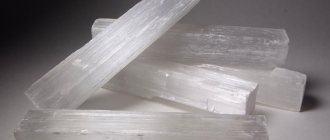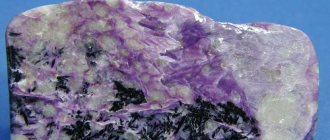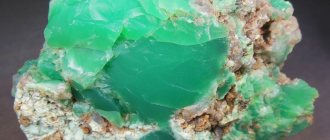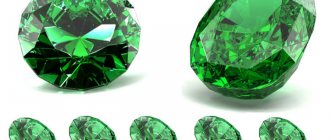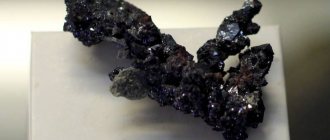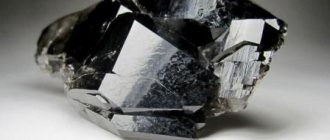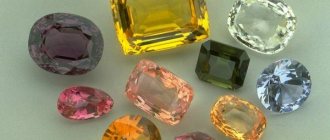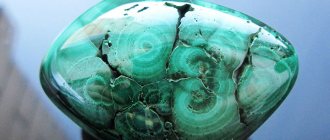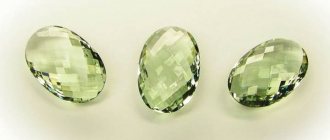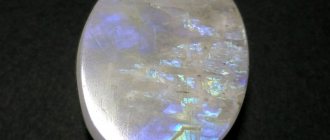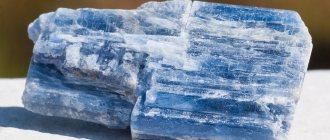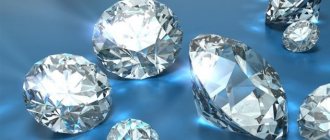More than two thousand years ago, a mineral of incredible beauty was discovered to humanity, the properties and power of which are still being studied today, but have not yet been fully revealed. Having passed through the history of many peoples, Labrador gradually opened up to new nations and continents, changing names, properties, and lives of people. Today this stone is a symbol of inexhaustible energy, bodily and spiritual harmony, the boundlessness of consciousness and subconsciousness.
Origin story
The mysterious gem was revealed to the world by an equally mysterious northern people - the Hyperboreans. It was they, according to legend, who were the first to discover not only the mineral, but also its strong magical properties. After some time, it became known that the Labrador faithfully serves a worthy owner, but leads to a quick death of a dishonest person.
This is interesting! One of the ancient myths describes Labradorite as moonlight falling on stones by a stream. The moonlight turned into a scattering of wonderful stones, yielding to the gaze of the sorceress.
The ancient Greek people revered the nugget as a sacred mineral. The Chaldeans, the priests of Babylon and Mesopotamia, showed a solidary attitude towards the gem. The rainbow reflections of the gem were considered a divine gaze. They prayed for the nugget, holding it in their hands or placing it above the window opening. Even then, people knew that a Labrador retriever should only have one owner, otherwise the gem would lose its power. Therefore, the best storage for a personal copy was a leather bag tied near the heart.
The Hindus of ancient times discovered in the nugget the ability to cherish the love of the family hearth. Spouses were supposed to have a pair of stones - male and female. Gems of greenish-blue tones were considered masculine, and brown-golden minerals were considered feminine.
Labrador acted as a messenger of heaven for the people of Kievan Rus. The gem was endowed with incredible healing powers sent from above. The mineral began to be widely used in the construction of cathedrals, temples, and tombs of rulers.
Passing through the centuries, the nugget was called by different names, it was mistaken for other minerals. So Labradorite was called black moonstone, fish eye, black opal, peacock stone. Later it was confused with labradorite, a rock.
The end of the 18th century was marked by several important stages in the history of stone. People have discovered large deposits of the mineral in Canada and Russia. As a result, Labradorite has gained extreme popularity in Europe. Fashionistas sought to decorate themselves with mineral jewelry, and complemented their homes with exquisite decorative items. Later, during the Soviet era, labradorite became a popular facing material in the construction of the subway and the Mausoleum.
The official name for the stone was given by the Canadian peninsula of Labrador, where the mineral was discovered. And on the territory of Russia, blocks of labradorite were found by chance, during the construction of the Hermitage. The popularity was not long in coming - all the Russian nobility did not miss the opportunity to decorate their apartments with gems. However, the mysterious mineral has not yet revealed to humanity the essence of some of its mysterious properties.
Description of the labradorite stone
The Labradorite stone owes its exceptional appearance to labradorite, a rock of volcanic origin. The stone is formed by a combination of elements such as quartz, plagioclase, feldspar and pyroxene. Its hardness is 6.5 on the Mohs scale. This is an incredibly beautiful mineral.
Since the stone is very beautiful, it is also called “peacock’s eye” and “Hyperborean rainbow”. And the stone received its official name in honor of the island of Labrador, where it was first found.
There are other deposits of it in the world, which are located in northern Europe and the Himalayas.
There are the following types of Labradorite stone:
- black Moon;
- spectrolite;
- lynx eye;
- Bulls-eye;
- Tawsit.
They differ in color, difference in composition and chemical and physical properties. However, all these varieties represent the same mineral, endowed with amazing qualities from nature.
The popularity of the Labrador has been growing for many years. For more than three centuries, people have been enjoying the beauty of products, crafts and furniture made with this mineral. They even decorate some Moscow metro stations and the Mausoleum.
Place of Birth
Canada and Ukraine are famous for the largest gem mining sites. In Russia, the mineral is mined in the Khabarovsk and Krasnoyarsk territories, Buryatia and Yakutia. The following states also have deposits of Labradorite:
- Mexico.
- Australia.
- India.
- USA.
- Brazil.
- Germany.
- Greenland.
- Burma.
- Mongolia.
The islands of Sri Lanka and Madagascar have the most beautiful examples with multi-colored iridescence. High-quality ornamental stone is found in Tibet. Unique specimens also come from Finland.
Also read: Epidote - a representative of the magical world of ornamental stones
Where is Labradorite mined?
Labradorite is widely distributed in nature. The breed is represented in different areas of the world, but it differs from each other and has individual external characteristics.
The largest deposit is located in Canada.
In Russia, Labradorite stones predominate in Eastern Siberia. Peacock stone also occurs on the Kola Peninsula and Kamchatka. The main deposits in the post-Soviet space today are concentrated in the massifs in Volyn and the Dnieper region (Ukraine). There are 26 known deposits in these areas, 6 of which have been geologically studied and two are being developed.
Physical properties
The mineral from the feldspar group is fragile, easily damaged by impact, melts at high temperatures, and is also susceptible to the harmful effects of acids.
| Property | Description |
| Formula | 30—50% NaAlSi3O8+50—70% CaAl2Si2O8 |
| Impurities | Fe, K, Mg |
| Hardness | 6-6,5 |
| Density | 2.69—2.70 g/cm³ |
| Refractive index | 1,560—1,568 |
| singonia | Triclinic. |
| Kink | Uneven, stepped and fragile. |
| Cleavage | Perfect. |
| Shine | Glassy to metallic. |
| Transparency | Opaque. |
| Color | Smoky gray, dark gray to almost black with a bright play of colors. |
An interesting feature of Labradorite is iridescence - the play of light on the surface of the stone, shimmering in different shades. This effect is inherent in the iris of our eyes, which is why Labradorite is often called peacock, fish, cat's eye and other similar names. The phenomenon of iridescence is also called labradorescence or labradorization. Rainbow highlights appear more pronounced on the treated surface of the stone.
Physico-chemical characteristics
Labradorite is a silicate. According to the IMA classification, a mineral and a solid solution at the same time.
The labradorization effect is due to cleavage and impurities.
| Acidity | SiO2 45-52% |
| Color | gray, brownish or almost black |
| Texture | massive |
| Density | 2,7 |
| Form of occurrence | laccoliths, lopoliths, dikes, stocks |
| Separateness | layered, parallelepipedal |
| Genesis | intrusive rock |
| Type | Igneous |
| Class | Plutonic |
| Squad | Basic |
| Suborder | Normal alkaline |
| Family | Gabbroids |
| View | Anorthosite |
| Variety | Labradorite |
| Main (typomorphic) minerals | Basic plagioclase (labradorite) |
Varieties of mineral
Labradorite is classified not by the shades of the mined specimens, but by its optical properties. Depending on the spectrum of light glare, the following types of mineral are distinguished:
- Spectrolite. A stone that shines with all the colors of the rainbow spectrum. This rare miracle of nature is mined in Finland.
- Black moonstone. A mineral endowed with blue or blue iridescence. Madagascar is considered the birthplace of this nugget. This type of gem was identified with a peacock feather, for which it was also called tausin.
- Sun stone. The gem comes from the United States of America with amazing golden iridescence.
It is the shimmering highlights that give the Labrador retriever its beauty and charm. The color of the stone varies between dark blue and gray shades, approaching black.
Do you know that in 1799 an extraordinary nugget was found in Russia, on the cut of which the profile of Louis XIV was clearly visible. This copy was immediately sold at a price of 250 francs.
At that time, Russia had already been swallowed up by the fashion for labrador decor - jewelry, interior items, room cladding. Even the dresses of noble fashionistas were made from a special type of silk called “tausin”. The color of the fabric accurately conveyed the shade of black moonstone.
Labradorite stone cost
Usually prices for craft materials are affordable. True, Labrador is an exception. The processing process is quite complex, so the cost increases. In addition, the stone is not very popular. For this reason, products with it are rarely bought, and therefore sellers include in the price of Labradorite the time it spent on the counter.
The cost of an average-sized cabochon is about 1,000 rubles. Small pieces will cost 500. The price of a piece of jewelry consists of the cost of stone, metal, specialist work and markup. A set consisting of earrings and a ring (weight from 7 to 10 grams) costs 2000-3000 rubles.
This is a stunning and unique stone. It has amazing healing and magical qualities that have no price. This mineral can make its owner truly happy. Labradorite enhances a person’s virtues and weakens his shortcomings.
Healing power
Labradorite contains a number of medicinal properties that affect not only individual problem areas, but the entire body as a whole. The stone is used by healers in cases of:
- hypertension;
- eye diseases;
- infectious and viral diseases;
- disorders of the nervous system (psychosis, stress, insomnia or anxious dreams, depressive states);
- problems with bones, muscles or joints.
In addition, lithotherapists note a positive result after a massage using any type of stone - joints become more mobile, muscle and other types of pain in the musculoskeletal system disappear, salt deposition slows down.
Among the capabilities of Labradorite, doctors note a general strengthening effect on the body. The stone ensures uninterrupted functioning of the immune system, normalizes metabolism, improves memory, and increases brain performance. This makes the mineral indispensable for people engaged in mental work.
The healing powers of the gem do not end there. Labrador is an assistant for women and men when there is a problem:
- infertility;
- impotence;
- diseases of the genitourinary system;
- kidney diseases;
- drug or alcohol addiction.
Labrador will help a woman not only conceive, but also bear a healthy child. Experts are also inclined to believe that the stone can prevent the development of cancer.
The unimaginable play of light makes the mineral not only visually attractive. Spectral changes on the surface of a mineral directly affect a person’s emotional state. Constant interaction with your Labrador improves your mood, helping you enjoy life without stress, insomnia or nightmares.
Also read: Sphene – shining like a diamond
Interesting Facts
Esotericists say that on a new moon the stone is cooler than usual and sparkles brighter. Check if you already have a Labrador.
British astrologers consider the rainbow stone a symbol of purity and chastity.
Among other magical properties, Labradorite is credited with the ability to bestow inspiration and support creative endeavors.
Some esotericists believe that light stones are more suitable for women. Dark Labradors have a “masculine character.”
The Smithsonian Institution in Washington is displaying a collection of cut yellow labradorite from US deposits.
In addition to jewelry, Labradorite has been actively used for a long time in the production of souvenirs and in the decoration of various premises. Thus, the stone was used in the design of the Mausoleum of V.I. Lenin, and in Tsarist Russia tabletops and snuff boxes were made from labradorite.
Important : the Labrador constantly absorbs the energy of the owner, which is discharged into space - negative and positive. It depends on you what kind of energy the rainbow stone will return to you.
Magical Aspects
It is not surprising that with such a set of medicinal properties, Labradorite is no less magically powerful. Since ancient times, it has been used by magicians and sorcerers to enhance their divination abilities. Modern psychics use the gem for spiritualistic seances, penetrating people's minds in order to read thoughts and reveal the secrets of the past or present. It is also known that the mineral, placed next to the pillow, causes prophetic dreams.
It is not easy to tame this gem, because the Labrador brings out all the hidden traits of the owner, and they do not always turn out to be good. It must be remembered that a stone can only have one owner. This applies not only to constantly wearing the mineral - it is not advisable for anyone to even touch the talisman if you do not want to destroy your tandem.
A sparkling nugget acts as a talisman for the family hearth. Moreover, for complete harmony, it is recommended to have stones of male and female origin. The lightest shades of the stone are considered masculine minerals, and the darkest shades are considered feminine minerals.
Any variety of Labrador is capable of developing intuition, which protects a person from wrong decisions and rash actions. The talisman activates the imagination, generating new ideas, promoting the development of a personality in harmony with oneself and the outside world.
Since ancient times, the mineral has been considered the guardian of creative people - poets, musicians, painters, sculptors. Nothing has changed over the centuries. By revealing talents, the stone pushes people to achieve the impossible, moving beyond the limits of their dreams.
Based on this, experts do not recommend wearing a Labradorite amulet to young, emotionally immature individuals. Such an alliance is fraught with the emergence of a craving for adventure, which can lead to disastrous consequences. Another thing is a person with a wealth of life experience who understands what he is doing and why.
The magical properties of labradorite stone
Fire endowed this mineral with wide possibilities. He has such strong energy that he helps even beginners in magic gain the most important and valuable knowledge. The magical properties of the Labradorite stone are so impressive that many sorcerers use it as a talisman.
If a person decides to devote himself to extrasensory perception, he needs a talisman that will appeal to him most. You should listen to the advice of your heart.
The magical properties of the Labradorite stone help you find your purpose, show the full potential given by nature and family, achieve tangible results in your professional activities, make your wildest desires come true and find your other half.
Who is the Labradorite stone suitable for due to its properties? It is very necessary for people who connect their lives with creativity. The mineral helps its owner find inspiration. Labradorite becomes the key to success and recognition of the works of its owner. This is a real talisman and assistant to creative people: writers, composers, actors and artists.
Thanks to the conjunction of the Moon and the Sun, the stone is endowed with the strongest energy. For this reason, it should not be worn by people under 27 years of age. Using the magic and enchantment of nature itself is a responsible task. You should not have a Labrador with you all the time. It is worth wearing products with it only in those situations that require it. He knows how to remain faithful and devoted, so temporary separation will not harm contact.
In the interior, you should opt for lynx eye and light tavusite. These types of minerals will cope with negative emotions, extinguish the emerging conflict, help resolve disagreements and make peace. Figures made from this stone not only become interior decorations, but also fill the house with a warm atmosphere.
When a couple is organizing a home, it would be optimal to purchase two figurines. You should buy a male stone with a light golden hue and a female version of brown or green color. In this way the two principles will come to harmony. You need to choose minerals together.
Labradorite figurines will be more comfortable away from prying eyes. However, you should not hide the stones too much. Sometimes they need sunlight and moonlight. This is how they replenish their energy reserves.
Under no circumstances should you give your mineral to strangers, this rule especially applies to a talisman. If you behave correctly, your Labrador will help you achieve success in all your endeavors.
Compatibility with other stones
Labradorite belongs to the element of Earth, which makes it compatible with its earthly counterparts:
- Morion;
- Jasper;
- Malachite;
- Turquoise;
- Lapis lazuli;
- Jade;
- Chalcedony.
Labradorite is favorable towards Water gems (opal, moonstone and alexandrite) and neutral towards Air stones (amazonite, citrine, rock crystal). Categorical incompatibility only with fiery representatives - garnet, topaz, onyx, carnelian and emerald.
Colors
The color palette of natural labradorite includes shades of gold, violet-red, blue-green, blue-orange.
The last two variations are especially popular in jewelry. Labradorite is interesting in jewelry because its surface is always dotted with strange patterns of several colors. In the bright sun, the stone shines brightly and shimmers in different colors.
Jewelry with mineral
Labradorite is widely used by jewelry makers. The price of a gem depends on its variety and degree of iridescence. Accordingly, the cost of a piece of jewelry is based on the price of the stone, the material of the frame and the work of the craftsman.
Average indicators fluctuate within the following limits:
- A silver ring costs from 10 thousand rubles, a gold ring with the highest grade of stone reaches 140 thousand rubles.
- Silver pendant – from 8 thousand.
- Earrings made of silver – 8-15 thousand rubles, gold – up to 160 thousand.
- A silver bracelet will cost an average of 14 thousand rubles.
Souvenirs are also made from Labradorite. The average cost of a small figurine is 5 thousand rubles.
Where is the stone used?
Aesthetic and physical conditions determine the scope of application of Labradorite.
Decor
The characteristics of the stone are similar to granite. It is used in much the same way. The Mausoleum, the central staircase of the main Russian library (Leninki), metro stations, government buildings, banks, and other high-status institutions are decorated with Labrador.
Labradorite monuments are more expensive than granite ones, but they look more presentable.
Polished slabs of stone become countertops, premium-segment fireplace mantels, and cladding the plinths of houses.
Labradorite countertop
Labradorite jewelry
The most interesting specimens of labradorite are intended for jewelers.
However, it is difficult to work with:
- The fragile, fractured stone is framed in white gold or silver.
- More often they make small inserts of rings, earrings, pendants, and small beads for necklaces or bracelets. There are no size restrictions when it comes to Australian gems. The pendant and ring with this labradorite are very beautiful.
- The surface of the stone is polished with a cabochon: this is how the iridescence appears in all its glory.
Jewelry with labradorite Products
made from several varieties of labradorite are especially aesthetically pleasing.
How to spot a fake
It is quite difficult to counterfeit Labradorite, as well as to pass off another mineral as it. The nugget owes this to the labradorization effect. Thanks to the rainbow highlights, the gem is difficult to confuse with another stone. Twist the Labradorite in your hand - if you don’t see something like the northern lights, as if passing through the stone, this is a fake.
Also read: Turquoise – a stone of happiness and prosperity
In addition, when buying jewelry, it is appropriate to ask to see a quality certificate for the stone. Large jewelry houses are required to have such documents for each product.
Areas of application
Labradorite is a valuable jewelry and ornamental stone. The most beautiful samples are used to make jewelry. These things are always in trend.
Paler stones are used to make small glyptics and designer items. If you have the money, you can use it for lining fireplaces, for example. True, for such decoration of premises you need to be a very wealthy person.
How to wear and care
Labradorite goes well with business style. A flawless white shirt will be accentuated with neat earrings with a mineral. Thus, it will be possible to create a discreet, intellectual, but at the same time very seductive image.
A charming evening dress will certainly cause a sensation when paired with a shimmering stone. This can be a massive necklace, a sophisticated pendant or a set of jewelry.
Labrador retrievers must be handled with care. The stone is very sensitive to acids, so it is not recommended to use chemicals for cleaning; it is enough to rinse the gem with running water.
Labrador Retrievers require regular polishing. A soft cloth or brush is suitable for these purposes. Polishing is necessary to maintain shine and shimmer.
It is better to store the stone separately from other jewelry, especially if the neighboring minerals are harder. A box with soft walls is perfect.
The gem is resistant to temperature changes, but you should not intentionally expose the mineral to such changes. It doesn’t hurt to periodically charge the mineral in the light of the Moon.
Wearing the stone continuously and daily is not recommended, since strong energy can be unpredictable, turning either in a positive or negative direction.
Labradorite formula
(Na0.50-0.30 Ca 0.50-0.70) [Al1.50-1.70 Si2.50-2.30O8]
Chemical composition
Theoretical composition of labradorite (An50-70): Na2O - 5.73-3.40; CaO - 10.38-14.36; Al2O3 - 28.30-31.70; Si02 - 55.59-50.54. Molecular weight 270.23-273.43
Varieties
Aventurine labradorite ( aventurine spar, aventurine - aventurine, sunstone - sunstone). Named for the red or pink internal glow caused by the reflection of light from small inclusions of ilmenite, magnetite or native copper. Described as phenocrysts from Modoc County, N.C. California, USA, and Lake County, pc. Oregon, USA. The fine sunstone was mined in Tvedestrand, Southern Norway.
Cloud plagioclases from Precambrian metadolerite dikes and compositionally similar young quartz dolerite dikes in the Bighorn Mountains. Wyoming, USA, detect a milky white or fiery red glow caused by reflection from tiny (~1 µm) inclusions of hematite or magnetite, oriented along the square. (010) or (001).
Compatibility with names and zodiac signs
A strong and mysterious Labrador is the patron of all women whose name is Yana. Intellectual by nature, Yana will be able to emphasize mental abilities, receiving wisdom from the stone on an intuitive level. The talisman will help her lower the veil of illusions, revealing the true face of those around her.
The fact that a stone belongs to only one name does not mean that others cannot wear it. The main requirement of a Labrador is character. The stone will destroy a wicked person, leading him to a dead end in life.
(“+++” – the stone fits perfectly, “+” – can be worn, “-” – is strictly contraindicated):
| Zodiac sign | Compatibility |
| Aries | — |
| Taurus | +++ |
| Twins | + |
| Cancer | +++ |
| a lion | — |
| Virgo | +++ |
| Scales | + |
| Scorpion | +++ |
| Sagittarius | — |
| Capricorn | + |
| Aquarius | + |
| Fish | +++ |
The nugget is ideal for water signs:
- Fish.
- Scorpion.
- Cancer.
For representatives of Water, the gem promises harmony and happiness, becoming a protector and friend.
In addition to these signs, the sparkling nugget is suitable:
- Virgos. The female half of the representatives of the sign will derive only good things from an alliance with Labrador. Virgo women will become reasonable, careful in their actions, bright, and energetic. The talisman will highlight only the best qualities of Virgos.
- Taurus. The mineral will bring them new knowledge and invaluable experience. Taurus will become more open and courageous, saying goodbye to old complexes.
Astrological incompatibility is observed with minerals of the element of Fire - Leo, Sagittarius, Aries. The stone will slow down such people, preventing them from achieving goals, building a career, family, and so on. At the same time, all negative qualities will be multiplied and displayed for others to see. An addition will be suddenly intensified outbursts of anger and nervousness.
Who is it suitable for?
Definitely not for children. It is recommended to wear a stone only from 25-30 years old. At this age you will be able to most fully experience and master all magical support. If you don't believe in the magic of stones, wear them
